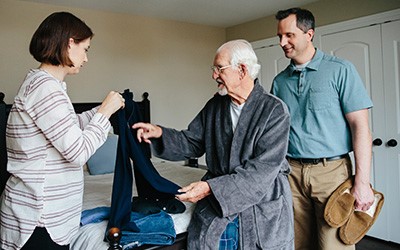The bedroom can be safe space for anyone and it is important for everyone to have a safe and relaxing place to sleep well at night, and a straightforward space to get ready in the morning.
It is particularly important to reduce clutter in the bedroom and make sure that there is lots of room around the bed. When a person is tired they may be more likely to trip and stumble.
Another potential risk is that a person with dementia may find it difficult to find or identify their bed. They should be able to see their bed easily from as many locations as possible and access it from both sides. Use contrasting bed linen and sheets to help define clearly the sleeping area. Bed covers are better in a colour that contrasts with the carpet. Ideally the bed should be visible from the toilet area so that when the person wakes up during the night they can see where they need to go and where to return to. This would help avoid people needing to ask where the toilet is and possibly not getting there in time which can be very distressing.

Another thing to consider is that people with dementia can be anxious and frightened when they see their reflection in a mirror because they may not recognise the person who is looking back at them. If mirrors are the problem, cover or remove them.
Dressing
There are a number of things that you can do to support a person with dementia to get dressed.

Plan plenty of time when supporting a person with dementia to get dressed. Rushing the person can cause anxiety and frustration. As the disease progresses beyond the early stages, choosing and putting on clothes can be frustrating for the person with dementia. The person may not remember how to dress or may be overwhelmed with the choices or the task itself.
It is important to do all that you can to involve the person in as many choices as possible. The simple act of choosing what to wear can become a very important part of a person’s identity.